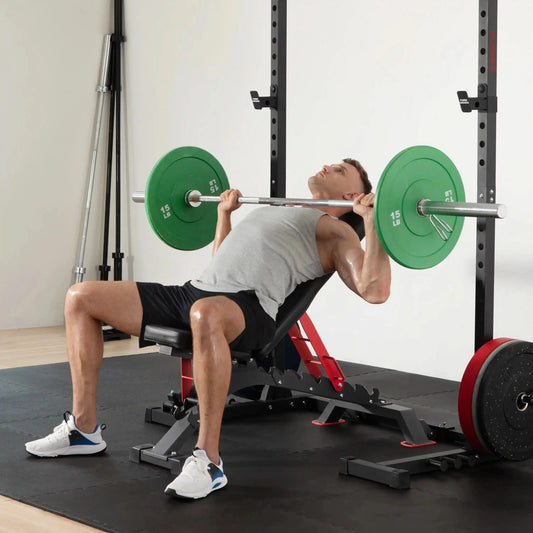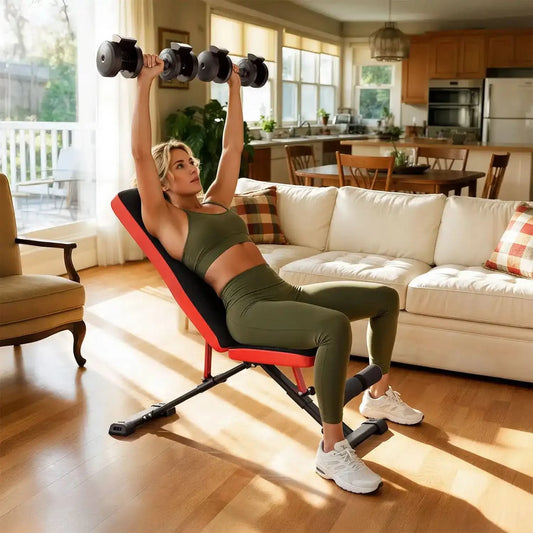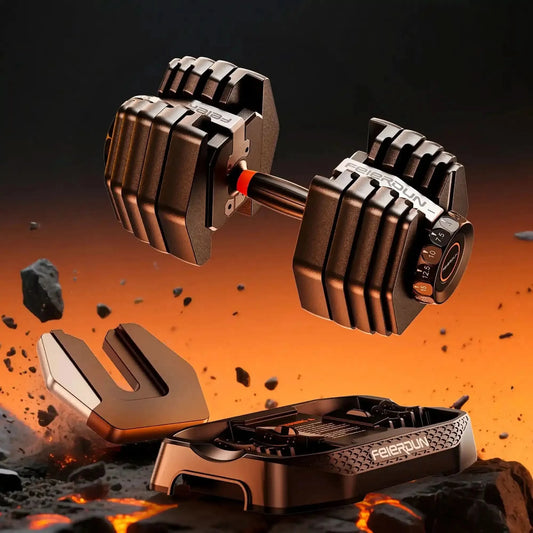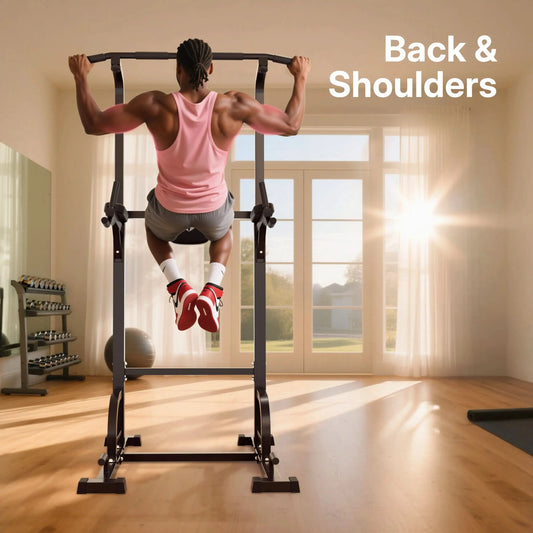There’s always debate about the right incline angle for the incline bench press: some say 30° is the sweet spot, while others disagree. This article breaks down the kinematics behind incline angles, how each affects muscle activation, and how to choose the right angle for your training goals.
Many lifters use the incline bench press every week, but few think about the angle of the bench. Most people just set the bench and start lifting. The incline angle is not just a small detail. It completely changes which muscles are working hardest during the exercise.
Your chest has three main parts: upper, middle, and lower. A flat bench works the middle chest more. At a low incline, the upper chest (clavicular head of the pectoralis major) is most active. At an elevated incline, the front deltoids (shoulders) get involved.
Knowing and using the right incline angle will help your chest look strong from top to bottom. It also helps protect your shoulders from strain. If you only use a flat bench, the top chest may look weak. If you make the angle too high, your chest works less and your shoulders get tired fast. So, knowing exactly what a specific incline angle does is crucial to target any specific set of muscles.
What is the Incline Bench Press?
The incline bench press is one of the most commonly used chest exercises. It's like the flat bench press, but the bench is inclined. Your body doesn't lie flat; it leans back with your head above your chest. A little adjustment like this makes the exercise feel different, hitting different muscles.
Almost all gyms have adjustable benches. These benches can move up and down to set different angles. The incline bench press angle can be between 15 and 60 degrees. A smaller angle, such as 15-30 degrees, will keep most of the work on the chest. A higher angle, 45-60 degrees, will involve more of the shoulders.
Why does this happen? At a lower angle, the press feels closer to a flat bench press, with the arms stretching and squeezing the upper chest the most as they rise and fall, meaning your upper chest gets the most work. As the angle increases, the press feels more like a shoulder press.
Effects of Different Angles on Muscle Activation
15–30 degrees: The Main exercise for our upper chest
When the bench is set at 15°-30°, the incline press targets primarilygood choice if you want balanced the upper chest, also known as the clavicular head of the pectoralis major. This area is more difficult to train with flat or decline presses, and that’s why so many lifters will add a low incline press into their chest training.
Upper Chest Focus:
- This range is often seen as the “sweet spot” for building the top part of the chest.
- The incline is enough to move stress away from the mid-chest, but not so high that shoulders take over.
This Angle Does Not Put Much Pressure on the Deltoid Muscles:
- Since the angle is not too steep, your front delts (shoulders) are less stressed.
- This assists lifters to concentrating on building the chest without straining the joints too much.
Stimulate Stronger Muscle Strength:
- The slight inclination will make it easier to feel the chest working.
- Many lifters find they can push heavier weights in this range.
Best Use:
- Excellent exercise to build muscle mass on the upper chest to give the look of a fuller, more balanced chest.
- It is suitable for both beginners and experienced lifters.
If you're still undecided between 15° and 30°, go with 30°. 30° is the best angle for training the upper chest muscles; most trainers suggest an inclination angle of approximately 30° for chest hypertrophy. If your main goal is to build a full, balanced chest with a strong upper portion, this is the best angle range.
30–45 Degrees: Balanced Chest and Shoulder Engagement
At 30°–45°, both the chest and shoulders are heavily involved. The upper chest is still working, but the front deltoids are more active compared to lower inclines.
Even Muscle Activation:
- Both the upper chest and shoulders work hard at this angle.
- The upper chest remains engaged, allowing for a balanced pressing action.
Functional Strength:
- This angle mimics real-life pushing motions like lifting boxes or pushing objects overhead.
- It builds strength that carries over into sports and daily activities.
Good for Growth:
- Since both the chest and shoulders are trained, muscle growth is distributed over a wider area.
- Therefore, many bodybuilders incorporate this angle into their workouts.
Potential Dangers:
- If the form is not correct, shoulder strain may occur.
- The shoulders may become overly fatigued if the exercise is performed too frequently.
Best Use:
If you want to work both your upper pecs and deltoids, a 30-45 degree incline is an excellent choice.
This makes it a good choice if you want balanced upper-body development. It’s also a practical angle for strength training, since you can typically lift more weight than at steeper settings.
45–60 Degrees: Mainly Exercises our Shoulder Muscles
When the bench goes past 45°, the exercise begins to look more like a seated shoulder press. At these angles, the anterior deltoids carry most of the load, while chest activation drops.
Shoulder Activation:
- The higher the incline, the more the front delts are engaged.
- At 60 degrees, the lift feels more like a seated shoulder press than a chest press.
Less Chest Involvement:
- The mid and lower chest are hardly active at this range.
- The upper chest is still working, but at a reduced level.
Joint Considerations:
- The steep angle exerts more pressure on the shoulder joints.
- Warm-up and proper form are both significant to prevent damage.
When to Use:
- When you primarily want to train your shoulders.
- Works well when combined with other chest-focused exercises on the same day.
Best for Variety:
- This angle should not be the main chest builder, but it can add variety.
- It’s useful for lifters who want to strengthen pushing power from different positions.
At 45-60 degrees, the incline press is useful but should not be used as a replacement for flat or lower-angle presses to develop chest muscles. It is most effective when used to combine chest and shoulder exercises and in balancing workouts.
Which Incline Angle is Best for You?
So, which angle is right for you? There is no right or wrong answer to this question. It entirely depends on your personal objective:
Scientific research shows:A 30° angle is the most recommended angle for the upper chest. Going steeper than 45° (at around 60°) makes exercise less of a chest press and more of a shoulder press.
Chest Hypertrophy (Muscle Growth):
Stay between 15° to 30°: 30° is best. It is a lower inclination, which maximizes activation of the upper chest and minimizes stress on the shoulder. It’s the most effective range for sculpting the clavicular head of the pectorals without turning the movement into a shoulder press.
Balanced Strength and Aesthetics:
The 30°–45 ° range should be good enough to target the chest and shoulders at the same time. It produces a more balanced workload between the pecs and the delts so that you can attain a fuller upper body look.
Shoulder Development:
Training at 45°–60° shifts the emphasis onto the front delts. This is ideal if your goal is to build shoulder strength and definition, though chest activation becomes secondary.
General Fitness:
In case you are more focused on your general overall upper body strength and joint fitness, then switching between the angles is the best solution. This variation allows you to train on different body angles and prevents overtraining and imbalanced muscular development.
How to Vorrectly Perform the Incline Bench Press
The incline bench press is one of the most popular upper-body exercises, but your technique must be spot on to avoid injury and get the most out of the exercise. Here is how to do it for maximum results and safety:
Step-by-Step Technique
To perform the incline bench press, do the following steps:
- Adjust the bench at 15 to 45 degrees.
- Sit back with feet firmly gripping the floor.
- Retract and squeeze your shoulder blades.
- Hold the bar a little wider than shoulder-width.
- Slowly lower the bar to the upper chest.
- Press the bar back up in a controlled path.
Bar Path and Grip Width
-
The bar path: The bar should move diagonally and should start above your shoulders and then move down toward the upper chest.
- Forearms perpendicular to the ground
-
Grip width: A grip, a little wider than the shoulder, limits the strain on the wrists and increases the involvement of the chest.
Breathing and Tempo
- Breathe in deeply as you lower the bar
-
Exhale forcefully as you press upward.
-
Tempo tip: A 2-3 second lowering phase with a controlled press enhances muscle tension and lessens the possibility of injury.
Importance of Proper Setup
-
Bench stability: Lock the bench and make sure it does not wobble.
-
Foot placement: Feet should be flat on the floor, providing a stable base so that the feet do not arch.
-
Shoulder Position: Tighten your shoulder blades and keep them tight to the bench.
Common Mistakes to Avoid
Whether you are a professional bodybuilder or just a rookie, there are some mistakes you need to avoid for maximum performance and to avoid injuries. Here are some common pitfalls to avoid:
Using too Steep an Angle
- An inclination of the bench to 60 or more degrees puts more emphasis on the shoulders rather than the chest.
- Maintain the bench at 15 to 45 degrees to get maximum chest activation.
Overarching the Lower Back
- A small natural arch is okay, but too much arching puts a strain on the spine.
- Engage your core and keep your feet flat to stabilize and not strain.
Bouncing the Bar off the Chest
- Momentum-derived movement minimizes muscle tension and can cause injury.
- Rather than lowering the bar with force, lower it slowly and stop, then press upward.
Poor Control at the Bottom Range
- A rapid lowering of the bar is too stressful on joints.
- A slow and controlled eccentric contraction will maximize strength and muscle growth.
Ego Lifting (Too Much Weight)
- Overloading causes poor form and a loss of muscle activation.
- Strict form and moderate weight increase strength more safely.
Avoiding these common mistakes will not only make you focus on the chest more efficiently, but also help you to exercise more safely and sustainably.
Practical Tips to Maximize Results
To make the most out of your incline bench press without causing yourself any injuries, it is important to remember the following techniques:
-
Warm up properly: Ensure that you warm up properly using lighter sets and dynamic exercises to activate muscles in the chest, shoulders and triceps. Proper warm-up improves performance and also reduces the possibility of injury.
-
Focus on form over load: Lifting with moderate weight and proper technique will engage the chest more than lifting heavy with poor control.
-
Use a controlled tempo: Lower the bar slowly and press up forcefully. By controlling both phases, you can achieve maximum muscle activation.
-
Use both dumbbells and barbells: Dumbbells and barbells together: The barbell bench press allows you to add more weight to build strength, while dumbbells provide a greater range of motion. For a more balanced workout, both should be used.
These practical tips will help you press more efficiently, reduce the chances of injury, and gradually gain upper chest strength.
Conclusion
There’s no single “best” incline angle.. The right angle is subject to your body, comfort, and training objectives. The recommended angle to work your upper chest is 30 degrees. It provides powerful chest activation, without stressing the shoulders.
To develop more shoulder strength, use a slightly higher angle (45-60). To achieve a balanced upper body, alternating between flat, incline, and even decline presses is a smart idea. This helps train various muscles of your chest.
If you are looking for a robust and adjustable weight bench to complement your chest and shoulder exercises, then do check out FED Fitness
adjustable bench. With its reinforced structure, anti-slip foot pads, and excellent stability, you can perform your exercises with confidence.














